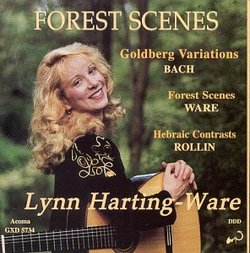| All Artists: Lynn Harting-Ware Title: Forest Scenes Members Wishing: 0 Total Copies: 0 Label: Acoma Original Release Date: 10/9/1995 Release Date: 10/9/1995 Genres: Special Interest, New Age, Classical Styles: Marches, Instrumental, Opera & Classical Vocal, Chamber Music, Historical Periods, Baroque (c.1600-1750) Number of Discs: 1 SwapaCD Credits: 1 UPC: 640139573428 |
Search - Lynn Harting-Ware :: Forest Scenes
 | Lynn Harting-Ware Forest Scenes Genres: Special Interest, New Age, Classical
In 1741, Bach wrote the Aria and 30 variations that comprise the Goldberg Variations. Described by Glenn Gould as ^Sthirty very interesting but independent-minded pieces^T, this work has become legendary in its virtuoso te... more » |
Larger Image |
CD Details
Synopsis
Album Description
In 1741, Bach wrote the Aria and 30 variations that comprise the Goldberg Variations. Described by Glenn Gould as ^Sthirty very interesting but independent-minded pieces^T, this work has become legendary in its virtuoso technical and interpretative requirements. Kenneth Gilbert describes it as ^Sa gigantic chaconne^T. However one thinks of this magnificent work, it is spellbinding in it beauty. Forest Scenes is a suite of three pieces with the general theme of nature. North Face opens boldly with brush strokes and snap pizzicato suggesting a violent wind. Later, a quiet tremolo evokes a sense of calm, but the tension mounts again building to its climax. Hibiscus on the Water contrasts in its pure lyricism. As a long-breathed melody unwinds over an undulating accompaniment, the music captures the beauty of fresh hibiscus blooms. Woodchuck Blues is a playful piece. Drawing from blues and jazz styles, syncopation, hemiola, blue notes and pizzicato combine to create a piece with real personality and pizzazz. Hebraic Contrasts is a collection of four movements extending from a piece recorded in 1990. Notable in Rollin^Rs style is the use of compound melody where the melodic line is displaced an octave or more. As this occurs, new lines emerge in contrasting registers, frequently resulting in a two-part dialogue punctuated with chords. Jewish folk melodies are interspersed in the second and fourth movements and add a sense of freshness and rhythmic vitality. Reverie and March was composed for a series of concerts in 1994 and is dedicated to my friend and colleague Gerhard Samuel. Inspired by the Berlioz Symphonie fantasique with its Dies Irae theme, I was impelled to bring the theme to the guitar in the Reverie.. The March presents a new theme in the upper voice, accompanied initially with free counterpoint and then with punctuating chords. A chromatic, rhythmic motive marks the phrases. The B section explores the March theme in a new melodic/rhythmic guise before the abridged return and closing chords. Drone is a study piece with driving energy and spirit. Richard Smoot derives it from the third movement of the Concerto for Guitar and Chamber Orchestra.

 Track Listings (22) - Disc #1
Track Listings (22) - Disc #1